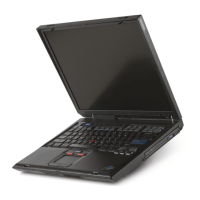Related service information
• If the battery indicator blinks orange, indicating that the
battery power is low. (Alternatively, if H ibernate when
ba ttery b e com es lo w has been selected in the “ Power
Management Properties” window, the computer goes
into hibernation mode.)
N ote fo r th e APM o p e ra tin g system :
Even if you do not set the low-battery alarm, the charge
indicator notifies you when the battery is low, and then the
com puter enters the power-saving mode automatically.
This default low-battery behavior is independent of the
operating system; so if you have set the low-battery alarm,
the computer may not do what you specified. It chooses
either your setting or the default setting, w hichever is
appropriate.
If you are using the ACPI operating system, only the
low-battery alarm is available.
To cause the com puter to return from standby mode and
resume operation, do one of the following:
• Press the Fn key.
• Open the LCD cover.
• Turn on the power switch.
Also, the com puter autom atically returns from standby
mode and resumes operation in either of the following
events:
• The ring indicator (RI) is signaled by a serial device or a
PC Card device (Windows 2000 does not support the
ring indicator (RI) resume by PC Card device.)
• The tim e set on the resume tim er elapses. In Windows
98, the S cheduled Tasks setting takes priority over the
R esum e on tim e r selection in the “Power Management
Properties” window.
Note: The computer does not accept any input
immediately after it enters standby mode. Wait a
few seconds before taking any action to reenter
operation mode.
Hibernation mode
Note fo r W in d o w s NT
If you are using Windows NT in the default format,
NTFS, you cannot create a hibernation file. If you
want to use hibernation mode, you will need to
reinstall Windows NT with FAT format.
In hibernation mode, the following occurs:
• The system status, RAM, VRAM, and setup data are
stored on the hard disk.
3 4 ThinkPad R40

